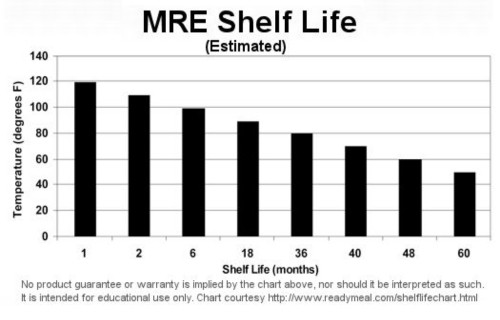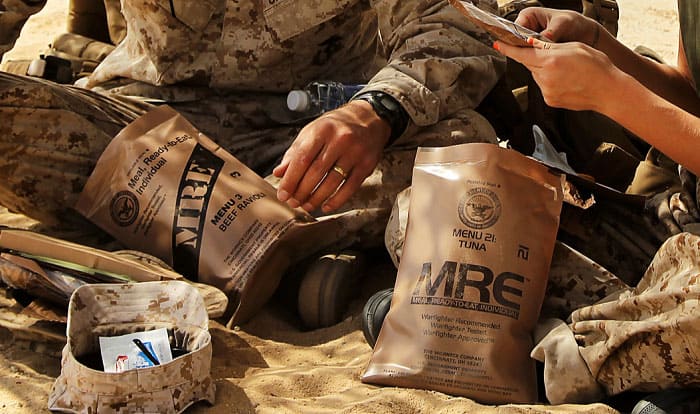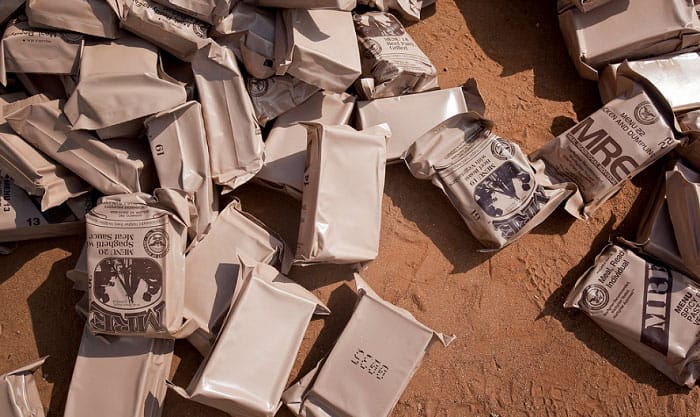If you do not already know, MREs are ready-to-eat meals in the military. They come as rations in sealed packages lighter than cans and durable enough to withstand drops and other forms of impact. Military members usually buy MREs in bulk for convenience.
However, this comes with the question, “How long do military MREs last?” Continue reading to find out! We will tell you, “How long are MREs good for?” and provide other relevant info.
Table of Contents
How Long Are MREs Good for?
MREs have a reputation for having the longest shelf life more than any other packed food. They are designed to last for a long time, even without being refrigerated. Moreover, they can endure extreme conditions. But as with all foods, they are not invincible and cannot last forever.
While there is no set MRE expiration date, its shelf life can be estimated.

- On average, at 75 degrees Fahrenheit, MREs can last for 5 years.
- At 80 degrees Fahrenheit, MREs are safe to eat for up to 3 years.
- In cooler temperatures, their shelf lives can extend beyond 10 years.
- But stored at 120 degrees Fahrenheit, the real shelf life of MREs is only about a month.
Why Can’t We Just Look at the Dates Stamped on the MRE?
MREs are not stamped with an expiration date because their shelf lives depend on how they are stored. Instead, if you look at the MRE packaging, you will find the ‘manufacturing date’ and the ‘MRE inspection date.’ Both of these are not the same as the expiration date.
1. The Manufacturing Date
This is a four-digit code, where the first digit indicates the year and the rest of the digits specify the day of the year. For instance, an MRE printed with 4169 denotes that it was manufactured on June 19, 2014.
2. The Inspection Date
Typically, the inspection date is 3 to 5 years after the meal was packed. As implied in the name, it is the date you are supposed to check in on the meals for any signs that it is going off.
3. Problems with The 4-Digit Code System
There are two main problems. First, it is difficult to figure out the day of the year without access to a calendar or the Internet. Second, you cannot differentiate between the decades. Since only 1 number is used to indicate the year, a “7″ for example, can be 2017 or 2007.
As a result, it is not easy to make plans on when to eat a certain MRE and to have peace of mind.
Signs That You Should NOT Eat Your MRE
To decide whether your MRE is still good and safe to eat, look for the following signs:
- Damaged Packaging: If your MRE pouches are torn, ripped, or punctured, air could have entered and spoiled the food content.
- Swollen Packaging: This is a strong indicator that there are botulism-causing bacteria. It is not safe to eat if this is the case.
That being said, if you decide to eat your MRE and realize it tastes funny or smells strange, it is best to ditch the package. Remember: better safe than sorry!
Some military MRE cases feature a time and temperature indicator. This is basically a label with two circles. The inner circle darkens over time and at higher temperatures, and when it is darker than the outer circle, you can take it as a sign the MRE has gone past its recommended shelf life.
It is also crucial to note that some content of an MRE may spoil faster than others. Spreads, such as cheese, applesauce, and peanut butter typically will not last long as packaged meals or candy.
Tips on Storing MREs
Like other foods, it is best to store MREs in places with cool, dry temperatures. Also, be sure to avoid direct sunlight and areas where rodents likely venture. Try to store them off the ground as well. This way, in case something leaks or spills, moisture cannot damage the MREs’ packaging.
It is not recommended to freeze MREs, as freezing can damage the laminated packaging, and if the contents are frozen, then thawed many times, they can spoil.
Conclusion
Now, you know the answer to, “How long do military MREs last?” It is helpful to keep what you have read in mind, as unlike other food items, the expiration date is not printed on MREs’ pack. If you liked this article, please leave comments for us. Share this with other readers as well!

I am Everett Bledsoe, taking on the responsibility of content producer for The Soldiers Project. My purpose in this project is to give honest reviews on the gear utilized and tested over time. Of course, you cannot go wrong when checking out our package of information and guide, too, as they come from reliable sources and years of experience.



